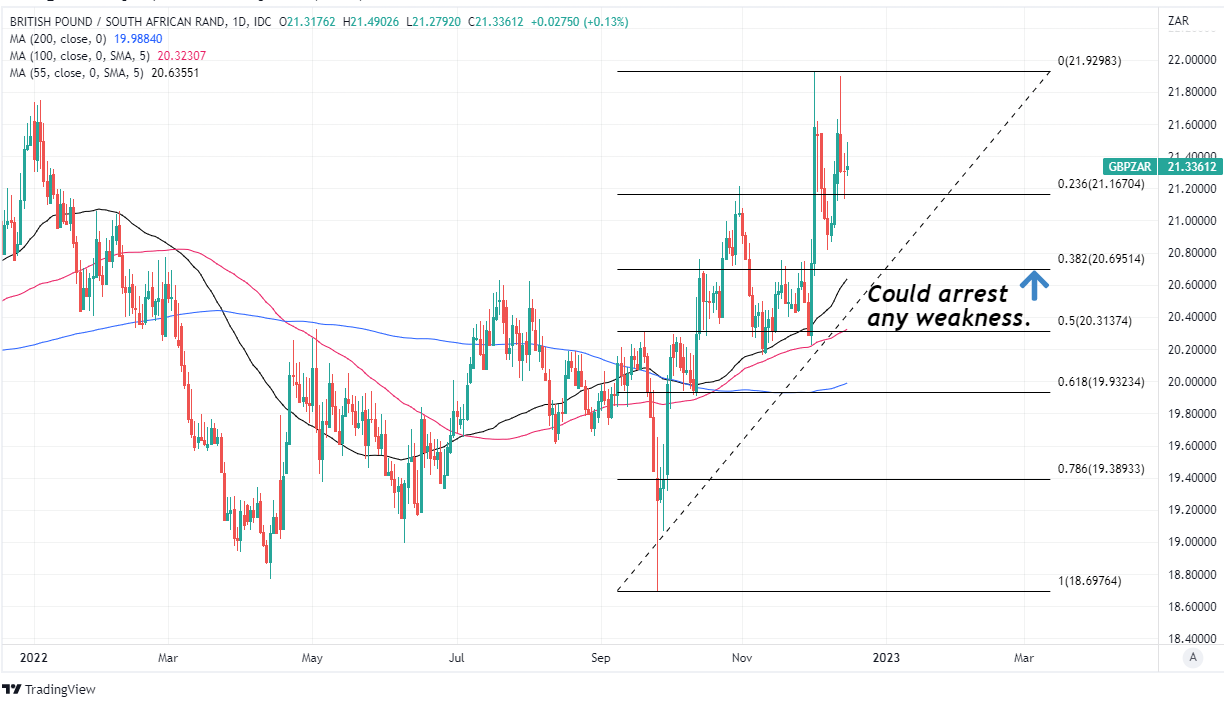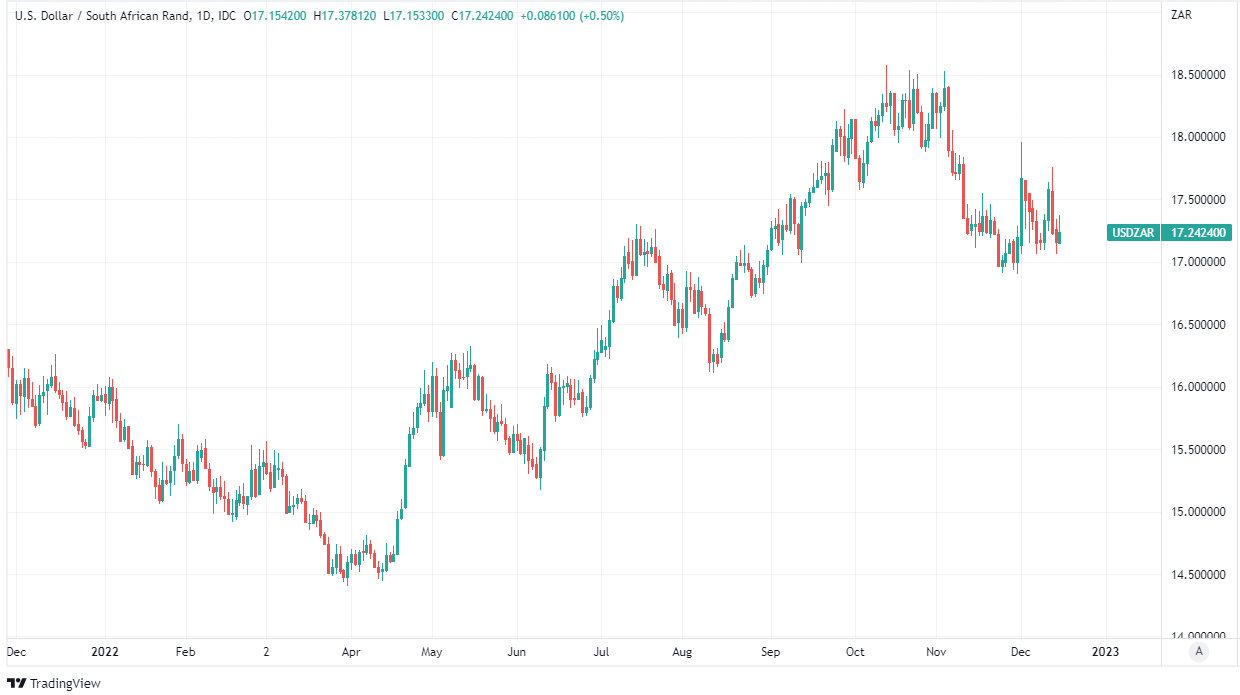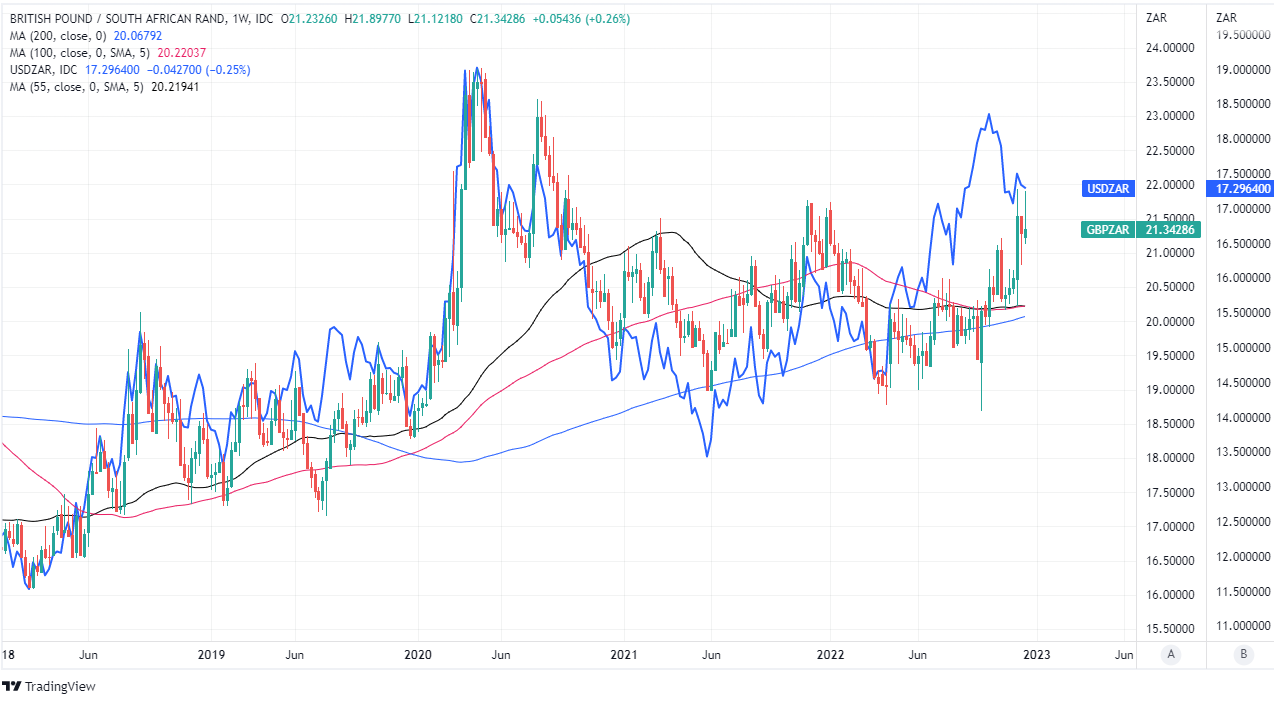Softer South African Rand Offsets Weaker Sterling to Support GBP/ZAR
- Written by: James Skinner
-
"From South Africa’s perspective, the SARB has been firmly focused on the exchange rate, inflation risks, and inflation expectations. Ongoing hikes from the Fed will ensure that the SARB keeps lifting the repo rate, albeit at a slower pace, in a bid to buttress the rand" - Matrix Fund Managers.

© Lefteris Papaulakis, Adobe Images
The South African Rand softened against most comparable currencies in recent trade with an underperformance that has helped to keep GBP/ZAR buoyant above 21.0 and near to this year's highs though a difficult outlook for the Pound could limit additional gains in the Sterling pair even if USD/ZAR climbs further.
South Africa's Rand was an underperformer over the week to Thursday despite a generally softer U.S. Dollar and small number of favourable developments on the domestic scene including receding political uncertainty and an ebbing of domestic inflation pressures for the November month.
Wednesday's parliamentary vote to reject the findings of an inquiry into President Cyril Ramaphosa's handling of a theft at a private residence has elimated the risk of an impeachment and destabilising power vacuum.
In addition, surprise weakness in November inflation rates in South Africa and elsewhere had this week appeared to ease pressure on the South African Reserve Bank (SARB) to continue lifting its interest rate, momentarily implying lesser headwinds than otherwise for the domestic economic outlook.
"While other central banks in EMEA have been losing enthusiasm to tighten policy, despite having inflation rates at multiple times their targets, the SARB is yet to signal that the MPC may pause the tightening cycle," says Izidor Flajsman, an emerging market and quantitative strategist at TD Securities.
 Above: Pound to Rand rate shown at daily intervals with Fibonacci retracements of September recovery indicating possible areas of technical support for Sterling. Click image for closer inspection.
Above: Pound to Rand rate shown at daily intervals with Fibonacci retracements of September recovery indicating possible areas of technical support for Sterling. Click image for closer inspection.
"During the latest press conference, Governor Kganyago even stressed that the SARB is committed to taming the monster of inflation. Today's print, in our view, is yet another signal that the SARB should slow the pace as well as duration of the tightening cycle," Flajsman writes in Wednesday market commentary.
The Rand was unable to capitalise much on favourable local developments this week and softened against many currencies on Thursday as the Dollar mounted an attempted comeback from earlier losses following the latest the interest rate decision and forecast update from the Federal Reserve.
Federal Open Market Committee members in the U.S. raised forecasts for Personal Consumption Expenditures (PCE) inflation in the U.S. on Wednesday this week and upgraded by around 75 basis points or three quarters of a percent the level that many of them expect to lift interest rates to in the near future.
"From South Africa’s perspective, the SARB has been firmly focused on the exchange rate, inflation risks, and inflation expectations," says Carmen Nel, a macro strategist at Matrix Fund Managers.
"Ongoing hikes from the Fed will ensure that the SARB keeps lifting the repo rate, albeit at a slower pace, in a bid to buttress the rand," she adds.
This month's updated forecasts suggested that a majority of FOMC members expect to lift the top end of the Fed Funds interest rate range to somewhere between 5.25% and 5.5% at the coming meetings and likely over the first half of next year, marking an upgrade from September's suggested peak of 4.75%.
 Above: USD/ZAR shown at daily intervals. Click image for closer inspection. If you are looking to protect or boost your international payment budget you could consider securing today's rate for use in the future, or set an order for your ideal rate when it is achieved, more information can be found here.
Above: USD/ZAR shown at daily intervals. Click image for closer inspection. If you are looking to protect or boost your international payment budget you could consider securing today's rate for use in the future, or set an order for your ideal rate when it is achieved, more information can be found here.
The latest forecasts imply upside risks to market expectations for Fed interest rates and downside risk to currencies like the Rand and Pound Sterling given that Chairman Jerome Powell said in Wednesday's press conference that recent falls in inflation were not enough to prevent a more hawkish policy outlook.
"Since the last FOMC meeting in early November, most EM currencies have appreciated significantly versus the Dollar. Some of this has been driven by China's ongoing reopening, which is progressing at a pace faster than we anticipated," writes Kamakshya Trivedi, co-head of global foreign exchange strategy at Goldman Sachs, in a Tuesday research briefing.
"At least some fraction of the EM FX appreciation we've seen since early November is attributable to expectations that the Fed will pivot in a more-dovish direction. And, while today’s CPI print was a meaningful contributor to an extension of those expectations, the road towards a sustained, dovish turn from the Fed is likely to be a long and bumpy one, and we think a course correction in market pricing remains an important risk," he adds.
Chairman Powell welcomed on Wednesday the recent declines in overall inflation but warned that unemployment remains too low and wage growth too high in many parts of the economy for the 2% target to be seen any time in the near future, hence the suggestion of a more protracted increase in interest rates.
This potentially poses more of an upside risk for USD/ZAR than for GBP/ZAR due to the uncertain outlook for the Pound, which itself remains burdened by a sinking economy and the prospect of further increases in interest rates.
 Above: Pound to Rand rate shown at weekly intervals with selected moving-averages. Click image for closer inspection. To optimise the timing of international payments you could consider setting a free FX rate alert here.
Above: Pound to Rand rate shown at weekly intervals with selected moving-averages. Click image for closer inspection. To optimise the timing of international payments you could consider setting a free FX rate alert here.











